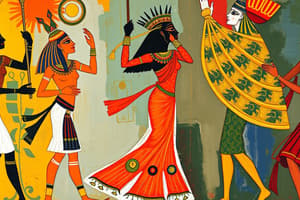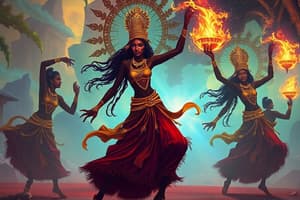Podcast
Questions and Answers
During which historical period did dance and art grow in popularity?
During which historical period did dance and art grow in popularity?
- The Dark Ages
- Ancient Greece
- Early Middle Ages
- The Renaissance (correct)
What significant development in dance took place in Italy due to new justice movements?
What significant development in dance took place in Italy due to new justice movements?
- Contemporary dance
- Ballet (correct)
- Hip-hop
- Jazz dance
Which dance style is NOT mentioned as a type of dance that surfaced during the Renaissance?
Which dance style is NOT mentioned as a type of dance that surfaced during the Renaissance?
- Break dancing (correct)
- Contemporary
- Ballet
- Folk dance
Which of the following dance styles is associated with social gatherings and community events?
Which of the following dance styles is associated with social gatherings and community events?
Which countries were highlighted for their contributions to the Italian and French dance systems?
Which countries were highlighted for their contributions to the Italian and French dance systems?
Which of the following styles is recognized as a blend of narrative and structured movement?
Which of the following styles is recognized as a blend of narrative and structured movement?
Which dance style is characterized by its energetic and improvisational nature?
Which dance style is characterized by its energetic and improvisational nature?
What was a major factor in the diffusion of various dance styles across nations?
What was a major factor in the diffusion of various dance styles across nations?
What role did dance play in early societies?
What role did dance play in early societies?
How was dance perceived in some historical periods?
How was dance perceived in some historical periods?
Which styles of dance gained popularity during the Renaissance?
Which styles of dance gained popularity during the Renaissance?
What was a characteristic of ball dances in the context of the Renaissance?
What was a characteristic of ball dances in the context of the Renaissance?
In which context did dance occur inside synagogues?
In which context did dance occur inside synagogues?
What was a common misconception about dance during some historical eras?
What was a common misconception about dance during some historical eras?
Which type of dance was not listed among the popular styles during the Renaissance?
Which type of dance was not listed among the popular styles during the Renaissance?
What societal changes influenced the perception of dance in early cultures?
What societal changes influenced the perception of dance in early cultures?
What has influenced the development of dance throughout history?
What has influenced the development of dance throughout history?
In which era did the real knowledge of dance begin to emerge?
In which era did the real knowledge of dance begin to emerge?
What is one of the main purposes of dance highlighted in the passage?
What is one of the main purposes of dance highlighted in the passage?
Which ancient civilization is noted for its contribution to the prosperity of dance?
Which ancient civilization is noted for its contribution to the prosperity of dance?
Which factor did NOT contribute to the flourishing of dance in the past?
Which factor did NOT contribute to the flourishing of dance in the past?
What did dance primarily serve as during the era of the Ancient Romans?
What did dance primarily serve as during the era of the Ancient Romans?
During which periods was dance recognized for its methods of attracting partners?
During which periods was dance recognized for its methods of attracting partners?
Which of the following best describes the primary role of dance in the prehistoric era?
Which of the following best describes the primary role of dance in the prehistoric era?
Flashcards
Ancient dance purposes
Ancient dance purposes
Dance was commonly used in religious rituals, social interaction, and communication.
Ancient civilizations and dance
Ancient civilizations and dance
Dance played a significant role in the cultures of ancient Egypt, Greece, and Rome.
Ancient dance applications
Ancient dance applications
Ancient dance was utilized for entertainment, military training, and conveying feelings.
Early dance evidence
Early dance evidence
Signup and view all the flashcards
Christian influence on dance
Christian influence on dance
Signup and view all the flashcards
Dance and Judaism
Dance and Judaism
Signup and view all the flashcards
Dance resurgence in Middle Ages
Dance resurgence in Middle Ages
Signup and view all the flashcards
Aristocratic dance
Aristocratic dance
Signup and view all the flashcards
Renaissance and dance
Renaissance and dance
Signup and view all the flashcards
Renaissance performers
Renaissance performers
Signup and view all the flashcards
Ballet origins
Ballet origins
Signup and view all the flashcards
Dance diversity
Dance diversity
Signup and view all the flashcards
Ballet
Ballet
Signup and view all the flashcards
Contemporary dance
Contemporary dance
Signup and view all the flashcards
Jazz dance
Jazz dance
Signup and view all the flashcards
Folk dance
Folk dance
Signup and view all the flashcards
Modern dance
Modern dance
Signup and view all the flashcards
Hip-hop dance
Hip-hop dance
Signup and view all the flashcards
Break dancing
Break dancing
Signup and view all the flashcards
Ballroom dance
Ballroom dance
Signup and view all the flashcards
Cheer dancing
Cheer dancing
Signup and view all the flashcards
Study Notes
Prehistoric and Ancient Dance
- Dance was used for religious rituals, communication, and social interactions.
- Dance played a significant role in ancient Egyptian, Greek, and Roman societies.
- It was used for entertainment, military training, and expressing joy.
- Early forms of dance are documented in Cave paintings and other archaeological evidence.
Early Middle Ages and Dark Ages
- There was a decline in dance practices in Western Europe due to Christian influence, seeing it as a frivolous activity.
- Dance associated with religious rituals within synagogues.
Middle Ages and Rise of Dance
- Public dancing became more prominent, with round dances and paired dances gaining popularity.
- Ballroom dances emerged as a result of aristocratic lifestyles.
Renaissance and Beyond
- Dance experienced a resurgence during the Renaissance, with a renewed appreciation for art and performance.
- Actors and musicians became valuable assets in Italian and French societies.
- The rise of ballet originated in Italy during this period.
- Various dance styles emerged and spread widely.
Modern Dance Styles
- Ballet is a highly structured and technical dance form that originated in the Renaissance.
- Contemporary Dance emphasizes fluidity, expression, and emotional depth. It breaks away from strict ballet techniques.
- Jazz Dance blends elements of ballet and modern dance with African-American influences, incorporating improvisation and rhythmic patterns.
- Folk Dance is a traditional style of dance that reflects the customs and traditions of different cultures and regions. It includes a wide range of dances from around the world.
- Modern Dance, often seen as a rebellion against the formality of ballet, explores movement, emotion, and personal expression.
- Hip-hop Dance is a dynamic and improvisational style that originated from street culture and emphasizes rhythmic movements, acrobatics, and personal style.
- Break Dancing, a subset of Hip-hop Dance, involves complex footwork, spins, and body isolations, creating dynamic and visually stunning routines.
- Ballroom Dance, a structured form of dancing, includes various styles like waltz, foxtrot, tango, and salsa, focusing on social interaction and specific steps.
- Cheer Dancing is a high-energy and spirited form of performance that often combines elements of dance, gymnastics, and cheerleading, usually used to support sports teams.
Studying That Suits You
Use AI to generate personalized quizzes and flashcards to suit your learning preferences.




